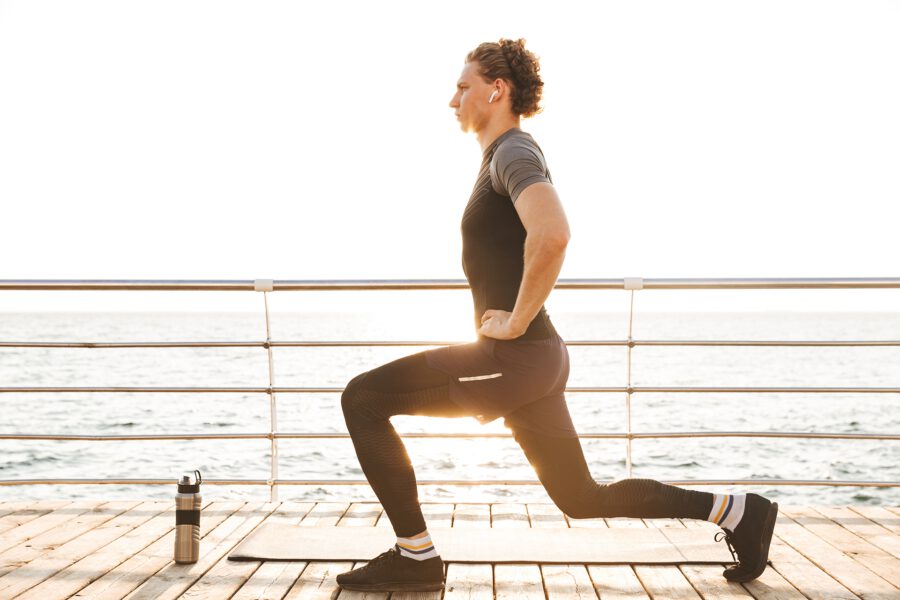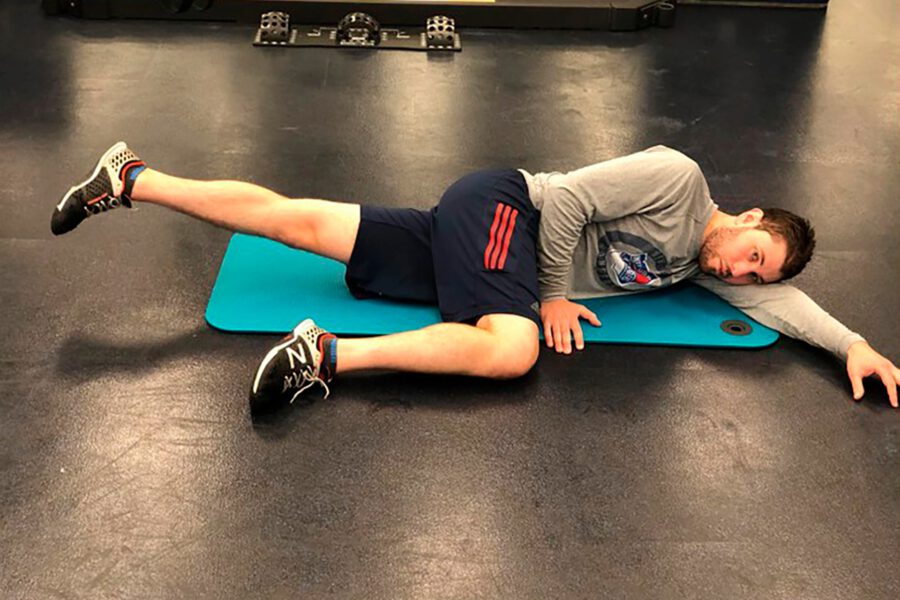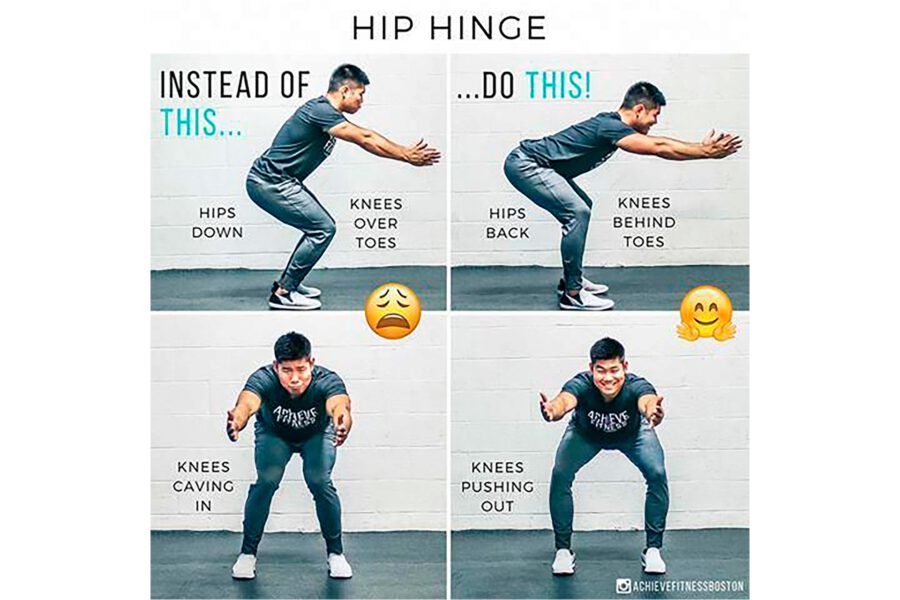Muscle Activation Exercises for The Legs
From time to time, you might notice something odd on your form or even a weird sensation that something is not quite right when you do a particular exercise.
For example, you may not feel the glutes contracting when doing squats, and your lower back gets a little bit more resistance than it should.
This may be a case of inactive gluteal muscles causing other muscle groups to compensate, resulting in poor form and inefficient movement.
Previous injuries or lifestyle habits such as sitting all day may cause your body to develop inhibition of the gluteal muscles and other unwanted movement patterns.
In other words, your brain either unconsciously adapts to forget using your glutes, or it learned to be dependent on other muscle groups. Now, this may become problematic since it alters your natural body mechanics, causing potential injuries and pain.
Previous injuries or lifestyle habits may cause inhibition of the muscles and other unwanted movement patterns, leading to pain and more injuries.
When you try to accomplish a specific task such as weightlifting, your brain fire signals to your muscle fibers to contract and perform the movement.
It is a complex mechanism of brain and muscle connection. Simply put, your brain dictates the command, and your muscle acts it. Therefore, your muscles may not perform very well without specific programming coming from the brain–that’s where muscle activation exercise comes in.
This article will show you different muscle activation exercises for your lower body to help you correct your form, improve your movements, decrease pain, and prevent injuries.
Muscle activation exercise prepares your mind (nervous system) and body (muscles) for the activities you are about to do, which are very similar to warmup and dynamic stretching exercises.
These exercises will “activate” specific muscle fibers to allow dynamic movement and improve your performance.
“Muscle activation exercise is vital in firing up the muscles that are needed prior an activity.
Elite athletes utilize these routines to maximize their performance.”
It trains your brain to fire up the targeted muscles and have them properly contract when needed.
These exercises are done in less than 10 minutes with fewer repetitions.
A palpable muscle contraction on the target muscle is a sign of successful muscle activation.
Here’s a list of exercises to active your legs:
Target muscles:
- Glutes
- Hamstrings
Single leg bridge fires up the deep muscles of your butt. It forces your glutes to activate and stabilize your pelvis during the exercise.
Be sure to squeeze your butt when lifting it off the ground.
- Step 1: Lay on your back with your hands on your side. Bend your knees and keep your feet flat on the floor. Tighten up your core. Extend your right leg in front of you.
- Step 2: Raise your hip off the mat. Keep your core engage. Squeeze your glutes. Hold for 5 seconds.
- Step 3: Feel the contraction of your glutes. Repeat for 5 to 10 reps and do it on the other side.
Keeping your glutes strong and active builds the stability of your body and improves your overall posture.
Single leg bridge exercise forces your glutes to activate. The glutes unconsciously shut down when you sit all day or have a back injury.
Target muscles:
- Quadriceps
- Hamstrings
- Glutes
Walking lunges are very effective to fire up the muscles of the lower body.
It warms up the quads, hams, and glutes while also challenging your balance to some degree.
- Step 1: Stand up straight with your feet shoulder-width apart.
- Step 2: Step your right leg forward as you give your body weight on the heel. As you step forward, bend your right knee. Then, lower it down so that it is parallel to the floor. Hold for 2 seconds.
- Step 3: Without moving your right leg. Repeat the movement on your left leg. Hold the position for 2 seconds.
- Step 4: Repeat the movements for 10 to 20 repetitions on each leg.
Strong quadriceps and hamstring are essential for the stability and control of your knees.
If you are engaged with high-impact sports, you should definitely try this exercise.
Walking lunges warm up the muscles of your thigh and help you increase your balance.
Target muscles:
- Hamstrings
Eccentric hamstring curl allows efficient contraction and firing of the hamstrings.
It also reduces the risk of having hamstring strains and tears.
The hamstring muscle is one of the most commonly injured muscles in high-impact sports.
- Step 1: Lie on your back. Place your heels on top of the stability ball while bending your knee so that you have a nice 90-degree angle.
- Step 2: Lift your glutes up. Squeeze your butt and engage your core. Maintain this position.
- Step 3: Slowly straighten your legs while keeping your heels on top of the ball and slowly curl back up using the hamstrings. Main the contraction of your hamstring throughout the movements.
- Step 4: Repeat the movements for 10 to 20 repetitions.
Sports like soccer and football rely heavily on the agility and strength of the hamstrings. Therefore, it is vital to keep your hamstrings ready and activated to prevent injuries.
Eccentric hamstring curl is a common therapeutic exercise for elite athletes. It mimics the activity of the hamstrings during high-intensity sports.
Here’s a calisthenics workout plan for women that will help you build strong legs and overall strength:
Here’s a calisthenics workout plan for men that will help you build strong legs and overall strength:
Target muscles:
- Hip adductors
This exercise promotes the activation of the inner thigh muscles, often inactivated or neglected during workout routines.
Training these muscle groups allows greater control and stability of the hip and pelvis.
- Step 1: Lie on your side left side. Bend your right leg in front of you so that your left leg will be free to move.
- Step 2: Contract your inner thigh and engage your core. Slowly lift your left leg up and maintain it for 6 seconds.
- Step 3: Slowly move back down to the starting position and do it again for 10 repetitions. Do it on the other side.
Activating the hip adductors can help you prevent and treat knee pain.
It also promotes control of your lower body during intense activity.
Excessive bowing or outward pointing of the knees during squats may signal a muscle weakness of the hip adductor muscle group.
Side-lying isometric adductor exercise is great for firing up weak muscles of your inner thigh. These muscles are vital for long distance running requiring significant hip and pelvic control.
Target muscles:
- Glutes
- Hamstrings
Hip hinge exercise allows you to simulate hip hinging motion in compound exercises such as deadlifts, squats, and kettlebell swings.
It activates the hip muscles and promotes control over the bowing of the hips during active contraction.
Training these muscle groups allows greater control and stability of the hip and pelvis.
- Step 1: Stand up straight shoulder-width apart. You can use a bar or stick, hold the weight in your hands with an overhand grip. Keep your back straight.
- Step 2: Lean forward like you are falling to the bar. Bend your knees slightly, but the majority of the movement should come to your hips.
- Step 3: When the bar passes the knee level, bring it back up to the starting position. Squeeze your glutes all the way to the top.
- Step 4: Repeat this movement for 10 to 20 reps.
This exercise trains a fundamental movement pattern that helps you safely perform an essential task such as bending over and picking up things from the ground.
The hip hinge exercise simulate the correct movements of the hip, allowing minimal stress on the spine during heavy lifting activities.
Muscle activation exercises can help you fire up “sleeping” muscles that are not working correctly to improve your form, posture and prevent injury.
Use these exercises to prepare your muscles for intense activities and improve the effectiveness of your workouts.
Remember that muscle activation exercises should make your muscles fatigue and tired.
It is because they are designed to “kickstart” your muscles and not to burn them out.


